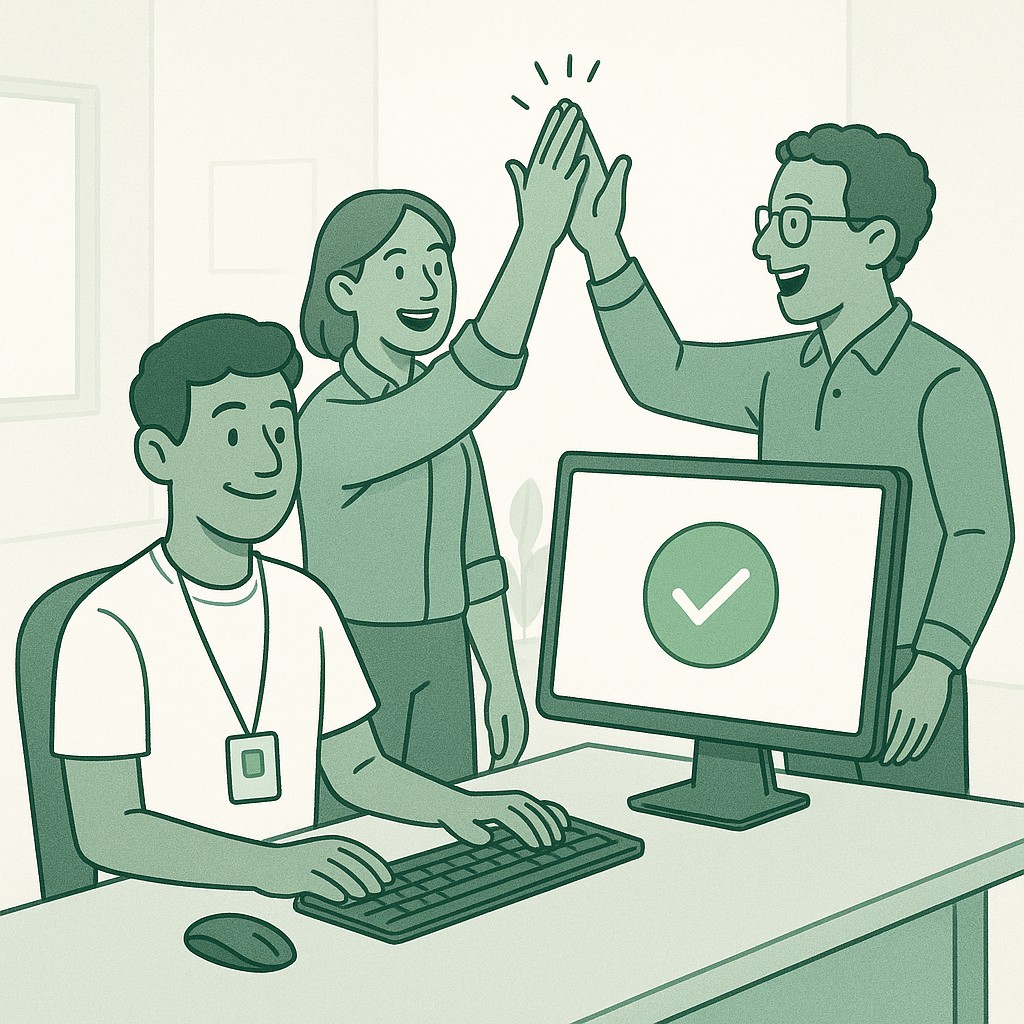Speed Up Developer Onboarding by Prioritizing Day 1 Momentum
Speed Up Developer Onboarding by Prioritizing Day 1 Momentum

Why Documentation-Heavy Onboarding Misses the Mark
I used to think that a mountain of SOPs, org charts, and policy docs were the answer to Day 1 nerves. If people had a big packet of information, maybe they’d feel ready. What actually happened was new hires spent their first week fighting with laptop setups, chasing down access, and quietly wondering if they were already falling behind. I watched sharp engineers lose steam before they even touched a commit. That was on me.
Here’s the shift. The real Day 1 deliverable is whatever helps speed up developer onboarding—not a neat stack of context and procedures. It’s momentum. If someone ends their first day with a working environment and a clear, achievable win, everything gets easier from there.
Information overload isn’t just annoying. It actively slows down new hires instead of helping reduce onboarding friction. When you pile on pages of docs without structure, you create cognitive overload and raise endless questions about dependencies. Nothing stalls a first contribution quite like searching for context in a sea of PDFs. I started thinking about how dashboards cut through confusion. Structured, prioritized information reduces cognitive load and quickens onboarding—a lesson dashboards taught us by making task completion faster and less error-prone. The flow matters more than the flood.
Looking back, the documentation-heavy approach didn’t set anyone up for success. Instead, it introduced friction and left people feeling behind before they even wrote a single line of code. I saw it happen and decided it was time to change.
If you want onboarding to actually work, don’t just focus on delivering clarity. Focus on building momentum, and you’ll get confidence as a byproduct. That’s where I’m headed next.
Momentum-First Onboarding to Speed Up Developer Onboarding: Building Confidence Through Real Work
Momentum-first onboarding is about cutting through the onboarding fog and finding a way to make progress visible—fast. Instead of hoping that clarity comes from a giant information dump, you focus on helping someone deliver something real on Day 1. It’s a working environment plus a purposeful, low-dependency win. The key isn’t that someone understands every acronym or subsystem, but that they see their work land and start to trust that they belong. I stopped optimizing for total clarity and started optimizing for motion.
Those developer onboarding quick wins—small, early contributions—carry a surprising amount of weight. When you nudge someone toward a modest, real task—making a code change, adding a test, tweaking a doc, or updating a logging statement—you jumpstart the feedback loop. Giving tailored first issues to new engineers helps them land early wins, see how the repo fits together, and surface the right questions. Instead of wandering through documents, they get to interact with the system in a way that’s grounded and immediate.
Six months ago, I watched a new hire spend a morning elbow-deep in a config file, only to realize half the variables weren’t even used anymore. We laughed about it later, but at the time, it felt like proof that momentum matters more than perfect docs. What stuck wasn’t the config detail—it was the process of poking around, asking questions, and getting something real to run.
If you’re thinking all this takes extra time or that skipping context is risky, I get it. That was my reflex too. I used to worry that quick wins were cosmetic—just something to pad onboarding checklists. Then I saw how early PR feedback unlocked the context people actually needed. When you put someone in motion, the questions start coming, and the teaching gets specific. Now, instead of force-feeding every possible scenario, we surround hands-on work with just-in-time coaching. The learning goes deeper because it’s tied to a real need. It’s not about shortcutting understanding—it’s about layering context so it actually sticks. Every meaningful win is a springboard.

The payoff: Day 1 developer impact means people get to value faster, and the confidence that comes from shipping compounds. Momentum begets learning. Learning begets bigger wins. You see it ripple across the team. Early progress turns into long-term impact.
Make Progress Inevitable: Prepping the Path Before Day 1
Before a new engineer even walks in, I want all the logistics sorted. Gear ordered. Tools configured. Accounts requested in advance. You’d be surprised how many brilliant hires get stuck on something basic, like waiting three days for repo access or a missing Slack invite. I test the whole path myself, step by step, imagining I’m new. If there’s anywhere to stumble, I want to spot it first—not them.
I work with my team to make environments portable and workflows reusable. When golden paths are repeatable, engineers put mental energy into actual product code—less setup friction, less cognitive drain, which helps accelerate developer onboarding. That’s the difference between half a day lost to config yak-shaving and someone shipping an actual fix by lunch.
When things just work on Day 1, it shows we’re ready for them. Not the other way around. That’s a subtle but powerful signal. You belong here; we want you moving, and the path is clear.
Still, even with prep, legacy systems or approvals sometimes throw up access walls. So I always line up fallback tasks. Mapping a feature, reviewing setup flows, reading docs, chasing down approvals, walking through tests, or poking at our logging. If production access drags on, they can still diagram a system, document a confusing bit in the workflow, or spot bottlenecks in our onboarding checklist. The goal isn’t busywork. It’s keeping momentum alive. I tell them: if you hit a wall, use the time to improve the experience for the next person. Flag snags, suggest fixes, clarify steps. That way, the “blocked” period still moves us forward.
I think about it like assembling a bike. I’m the type who learns by doing, not by memorizing every diagram. I’ll skim the manual for torque specs, sure, but mostly I just want to start turning bolts and see how it fits together.
That’s why I give new hires ownership early. Ask them to fix what confused them, clean up rough edges, or add that missing note in the setup script while their perspective is fresh. They’re the only ones who still see what’s broken. You can’t spot potholes from the driver’s seat if you’ve been on the road for years. Empowering them to patch the path behind them—right as they walk it—means every cycle gets smoother for the next person.
Replace Static Docs With Live Context: Interactive Onboarding Loops
After standup each morning, I intentionally block off ten minutes with no agenda. It’s open Q&A, focused on whatever people are working on that day. Not hypotheticals, not process deep-dives. This lightweight slot lets real questions bubble up. Not just the ones that fit in a standard checklist or doc.
Static documentation is still there, but in a progressive onboarding strategy it’s backup, not the main event. Trust me, real conversations beat static docs every time. If someone asks about why we do something a certain way, walking through it live is always faster, and the learning sticks better.
In those first weeks, I set up 1:1s across the team and with business partners—engineers, designers, sometimes even ops or support leads. Not all at once. I spread them out, two or three per week. These calls aren’t chores. They’re a map. You get the names, personalities, and the genuine priorities behind parts of the codebase. I remember how just knowing who owned what made it easier to move quickly and ask good questions.
Then come early code reviews and approvals. I like to keep these concrete. Walking through a pull request together, poking at the edges, and explaining the “why” behind a comment or change. This is where the system itself starts teaching. Architecture patterns, security gotchas, data quirks. Approvals are more than gatekeeping; they’re live context, pulling new folks into the flow and letting them see what matters right now, not just what’s written in a doc.
I model curiosity every chance I get. I say “I don’t know—let’s find out” on purpose, especially in front of new hires. The goal is to normalize follow-up questions and show that learning is an ongoing loop. If someone asks something I haven’t thought about, we chase it down publicly. That way, next time the same question pops up, the answer is visible to everyone. Confusion compounds less and the confidence compounds more.
That config file moment I mentioned earlier still crops up—the variables change, the questions don’t. Somehow, those little puzzles keep the onboarding process human.
Momentum Beats Bottlenecks: Why Fast Shipping Wins
I see the hesitation. You worry that sending new hires into real work before they’ve absorbed everything is reckless, or that not marinating in context means they’ll make mistakes. Honestly, I used to feel the same way. What changed my mind was watching engineers learn faster in code reviews than they ever did from binder overload. Quick wins aren’t superficial when they’re grounded in real code and paired with direct feedback. That’s where context starts sinking in. Skipping a reading marathon isn’t cutting corners if you layer in what actually matters, right where it’s needed.
Momentum-first onboarding works because you speed up developer onboarding by reducing the surface area for confusion and dependency dead-ends. Or, more simply: people ship, sooner. When I look for indicators, I care about Day 1 ship rates, early PR velocity, and how much time new folks spend unblocking themselves versus chasing approvals. You want fewer “waiting for access” tickets and more “ready for review” pings. That’s the heart of it. Try this with your next hire: one setup tested, one task they can finish on Day 1, and real feedback inside their first week. Start small, and watch how quickly momentum builds.
You’re here for better onboarding, but if you also write posts, release notes, or internal guides, use our app to generate AI-powered drafts fast, tailored to your goals, constraints, and tone.
Some days, I still get the balance wrong. I know the value of context, but sometimes I overcompensate. I’m convinced momentum is king, but every so often, I catch myself worrying about all the tiny details that didn’t get explained. I haven’t found the perfect formula—and honestly, I might never—but momentum keeps winning.
Enjoyed this post? For more insights on engineering leadership, mindful productivity, and navigating the modern workday, follow me on LinkedIn to stay inspired and join the conversation.
You can also view and comment on the original post here .
